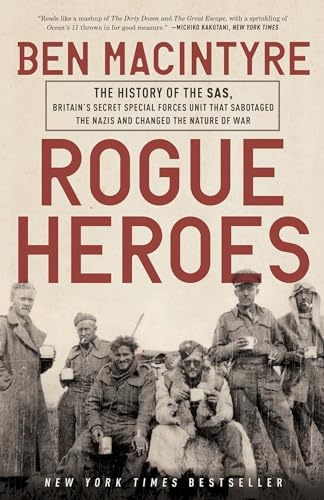Grab your goggles and khaki shorts, because this is my review of Rogue Heroes! I’ve spent many late nights flipping these pages, and boy, if you’re a fan of wild true stories, this book brings the goods. It’s the real-life tale of the first SAS soldiers – a bunch of lovable troublemakers who made World War II history, one sneaky raid at a time. I’ll walk you through what makes this book such a fun read, the heroes (and oddballs) you’ll meet, plus a few spots where the story trips over its own boots. Let’s get started and see if this wild wartime adventure is worth your precious reading hours!
Rogue Heroes: A Wild Ride Through History
In a nutsheel
Ben Macintyre’s Rogue Heroes is a non-fiction adventure that reads like a war movie your grandad would never let you watch as a kid. It tells the wild story of the SAS—the Special Air Service—for folks who like real history with a side of mayhem. You get fearless oddballs, big egos, and insane missions behind enemy lines. The book packs in friendship, bravery, and the blurry line between hero and rascal. Macintyre keeps things real without putting you to sleep. If you enjoy true tales about unlikely heroes doing unthinkable stuff, this is your ticket.
The Birth of the SAS: How ‘Rogue Heroes’ Unpacks a Wild Beginning
If you ever wondered if a bunch of misfits could beat the Nazis using jeeps, sand, and pure cheek—well, ‘Rogue Heroes’ has got your back. The book throws you right into the wild, windy deserts of North Africa, the birthplace of the Special Air Service, or SAS, during World War II. The guys in charge at the time must have been desperate—or slightly mad—because who else but a crazy person would say, “Sure, let’s parachute into a desert at night for fun”? I can’t even find my socks after 8pm, let alone fight Germans under the moon.
David Stirling, the main brain, didn’t look like a soldier. He looked more like a fellow who’d spill tea on your rug. But ‘Rogue Heroes’ shows how he pitched his off-the-wall plan to the generals: create a tiny, sneaky unit to cause chaos behind enemy lines. They wanted volunteers, but the weird requirement was: must not like following rules. My friend Tom would’ve signed up instantly if he wasn’t afraid of sunburn.
What I love in ‘Rogue Heroes’ is the honesty. It doesn’t pretend these guys were action movie stars. They argued, joked, and sometimes just messed up. But their scrappy spirit made history. You learn how their oddball ways slowly built the legend of the SAS. If you want to know how a bunch of rule-breakers made their own rules and built a team, this is your book.
But what did these wild guys do next? Next up, I’ll tell you about the real-life action that makes most action movies look tame.
Real-life Action: Explosions, Laughter, and More Explosions
If you think the stories in Rogue Heroes sound like Hollywood scripts, you’re only half right. The book is loaded with mission stories so wild I had to check if my copy came with popcorn. These SAS folks didn’t just skulk about in the desert—nope, they went big or went home, and usually brought some extra fireworks along.
Take, for example, the time the team raided enemy airfields. These weren’t neat, polite affairs. Flames, noise, and good old-fashioned British cheek made every mission sound like a party—if your idea of a party includes dodging bullets and running through sand in the dark. Rogue Heroes gives you the nitty-gritty: the botched jumps, the broken Jeeps, and the awkward moments when things blew up at the wrong time. It’s honesty served with a twist of madcap fun. I could almost hear the author’s voice laughing along as he described a parachute drop gone so wrong, the only casualty was a fruitcake intended for Christmas.
But it’s not just ‘boom, bang, kablam!’ The book shows how these missions changed the war—and probably a few pairs of underpants. The men behind these feats bickered, joked, and sometimes questioned their own sanity.
So, if you fancy reading about real-life heroes with more guts than sense, this book won’t disappoint. Next time, I’ll be chatting about the wild personalities and zany leadership styles that made the SAS so very, very special—brace yourself for eccentric mustaches and surprise tea breaks!
Unforgettable Leaders and Eccentric Characters in Rogue Heroes
If there’s one thing I learned from Rogue Heroes, it’s that history is far from boring. The people in this book would make even my loud uncle at Thanksgiving seem tame. Every page seems to bring a new wacky personality to the table. For starters, David Stirling (aka the big boss) leads with a mix of stubbornness and wild ideas. His leadership style? Well, let’s just say the guy basically invented ‘winging it.’ I’ve had group projects in school with less chaos, and that’s saying a lot.
But wait, the supporting cast is just as fun. Jock Lewes, the brains, is obsessed with gadgets and planning ahead — sort of the ‘Q’ to Stirling’s 007, but with a much snappier temper. Paddy Mayne also steals the show. He’s like if a rugby player, poet, and troublemaker all merged into one guy. I bet he would’ve stolen my lunch money and then written me a sad poem about it. These men kept the SAS rolling with a blend of sarcasm, guts, and not much patience for orders.
The best (or maybe worst?) part is that none of these folks fit your regular soldier mold. The author, Ben Macintyre, makes it clear that the SAS worked because it attracted misfits, rebels, and people who were allergic to rules. Somehow, that’s what made it all tick, like the world’s most dangerous clown car.
Now, if you’re wondering just how Macintyre brings these wild folks to life on the page, buckle up—next I’ll talk about his writing style and what makes the storytelling tick (or explode, depending on the chapter).
Storytelling That Packs a Punch: Writing Style in Rogue Heroes Book
So, let’s talk about writing style. After all, you’re here for a story about chaos, courage, and blowing up things in the desert, not a bedtime tale about tax returns. Ben Macintyre, the author of Rogue Heroes, clearly got that memo! His words crackle with energy—just like a grenade tossed into an enemy camp. He peppers every chapter with little details that make the men pop off the page. I laughed out loud at some of the wild stories, and I’m not one to cackle in public (usually).
If you’re scared of military jargon, relax. Macintyre keeps the pace brisk and the sentences short, so you never feel bogged down by technical stuff. Even when he describes how someone’s moustache flapped in the desert wind (yes, really), he keeps it light and sharp. You’ll feel like you’re on the ride with the SAS gang, sand in your shoes and all. He flips from one viewpoint to another, making it feel like a Netflix series that just won’t let you turn it off.
On the downside, sometimes there’s so much going on that you wish he’d slow down for a breather, maybe let us finish our cup of tea before the next explosion. But hey, war waits for no one—not even readers with caffeine addictions!
Would I recommend Rogue Heroes? Oh yes! If you want history that grabs you by the collar and yells ‘hang on!’—this is your book.
Conclusion
So there you have it—my two cents on Rogue Heroes. This book is a wild ride through history, packed with big personalities, explosions, and just enough British chaos to make you snort your tea. Ben Macintyre keeps things fast and fun, even when he’s writing about serious stuff. You’ll learn a lot about the SAS, and you won’t even need a dictionary. If you want adventure and real-life action, you’ll have a blast. But, if you like books super neat and slow, this one might feel a bit much. Either way, it’s been a hoot sharing my thoughts. Now go have your own misfit adventure—just, you know, maybe don’t blow anything up.


